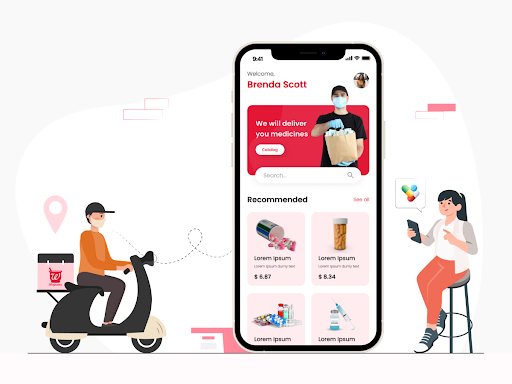The online pharmacy market is poised for significant growth in the coming years. Analysts predict an annual growth rate of approximately 11.57% from 2024 to 2028.
Market revenue, which is projected to reach $52.51 billion by 2024, is expected to soar to $81.37 billion by 2028.
In this expanding sector, developing a medicine delivery app for your retail business can be highly advantageous. However, to stand out in a crowded marketplace, your app must address the common challenges faced by online pharmacy customers. A study by the National Library of Medicine highlights various issues with online pharmacy purchases, such as the illegal sale of prescription drugs, order refusals due to expired medications, and product defects, among others. Creating an app that focuses on resolving these issues can help you establish a strong presence as “One in a billion.”
What is a Medicine Delivery App?
A medicine delivery app is a mobile application designed to facilitate the purchase and delivery of pharmaceutical products directly to consumers’ doorsteps. These apps offer a convenient and efficient way for users to obtain medications and healthcare products without having to visit a physical pharmacy.
Key Features of a Medicine Delivery App:
- User Registration and Profile Management
- Search and Browse
- Prescription Management
- Ordering and Payment
- Delivery Management
- Reminders and Notifications
- Customer Support
Benefits of a Medicine Delivery App
- Users can order medicines from the comfort of their homes, avoiding the need to travel to a pharmacy.
- Quick ordering process and home delivery save time, especially for those with busy schedules or mobility issues.
- Easy access to a wide range of medicines and healthcare products, including those not readily available in local pharmacies.
- Medication reminders and easy prescription refills help users adhere to their prescribed medication schedules.
- Especially important during health crises like the COVID-19 pandemic, reducing the need for physical visits and potential exposure.
Popular Examples of Medicine Delivery Apps
- PharmEasy: Offers a wide range of medicines, health products, and lab tests with home delivery.
- Netmeds: Provides access to prescription and OTC medications, along with health consultations.
- 1mg: Combines medicine delivery with healthcare services such as lab tests and online doctor consultations.
Steps To Develop Medicine Delivery App Development
In the rapidly evolving healthcare industry, medicine delivery apps have become essential tools, offering convenience and accessibility to consumers. Developing a successful medicine delivery app requires careful planning, a clear understanding of user needs, and attention to regulatory compliance. Here’s a comprehensive guide to help you through the process:
1. Market Research and Planning
Start by conducting thorough market research to understand the demand, target audience, and competition. Identify the specific needs and pain points of your potential users. Develop a detailed business plan outlining your app’s unique value proposition, revenue model, and growth strategy.
2. Define Key Features
Ensure your medicine delivery app includes essential features that enhance user experience and streamline operations:
3. Regulatory Compliance
Ensure your app complies with healthcare regulations and standards such as HIPAA in the United States or GDPR in Europe. This includes secure handling of personal and medical data, maintaining patient confidentiality, and ensuring all transactions are encrypted and secure.
4. Design and User Experience
Focus on creating a user-friendly design with an intuitive interface. The app should be easy to navigate, with clear instructions and a seamless flow from browsing to ordering. Consider accessibility features to cater to users with disabilities.
5. Technology Stack
Choose the right technology stack to ensure your app is scalable, secure, and efficient. Commonly used technologies include:
- Frontend: React Native, Flutter for cross-platform development.
- Backend: Node.js, Django, or Ruby on Rails for robust server-side operations.
- Database: MySQL, MongoDB for secure and reliable data storage.
- Cloud Services: AWS, Google Cloud for hosting and scalable infrastructure.
- Payment Gateway Integration: Stripe, PayPal for secure transactions.
6. Development Process
Follow an agile development methodology to allow iterative progress and flexibility. Break down the development process into sprints, focusing on building and testing individual features before moving on to the next.
7. Testing
Conduct thorough testing to identify and fix bugs and ensure the app performs well under various conditions. This includes:
Conclusion
Developing a medicine delivery app is a complex yet rewarding endeavor. By following this comprehensive guide, you can create an app that not only meets the needs of users but also stands out in the competitive healthcare market. And for detail you can contact to any medicine delivery app development company. Focus on delivering a seamless, secure, and user-friendly experience, and you’ll be well on your way to success.
